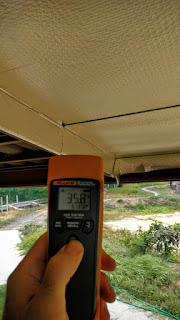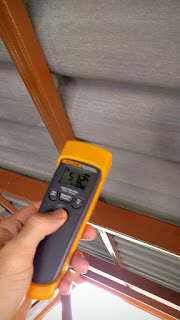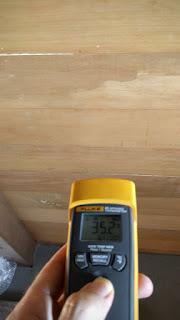Continuing my recent exploration of different insulation options, I decided to install them and test how well they can block the heat of the sun baking down on a roof.
My methodology is to install the insulation on a roof, then compare the temperature of the underside of the roof, the underside of the insulation, and the ambient temperature in the shade. The temperature of the underside of the insulation isn’t an exact measure of the rate at which heat will flow into the room, but it should be a reasonably close proxy. If the contact surface between the insulation and the air isn’t very hot, then there won’t be much of a temperature differential for the heat to transfer into the room.
Let’s start with the metal foil insulation we installed on the underside of the balcony roof in BaanMae:
It is a thin (<5mm thick) double sided metal foil with circular air gaps between the two sides. It claimed to have an R-value of about 12 (if I remember correctly). From the picture above you can see that the temperature of the foil is about 35.8C.
As for the underside of the roof:
It reads 50.4C.
And pointing the thermometer at a nearby wall (shaded by the roof) gives us an ambient temperature of 35.6C.
So the underside of the insulation is almost exactly ambient temperature while the roof is about 15C hotter. I have a few doubts about this test due to the fact that the foil may be reflecting the infrared light that the thermometer is using for measurement. But touching the foil felt very similar to touching the wall, so it can’t be way off. I may try this test again by putting a piece of tape on the foil surface to remove any doubts about the temperature sensor.
Next we will look at the spray foam insulation I applied a little bit of to the underside of the roof in BaanRimNaam:
The temperature of the insulation is 36.4C
The temperature of nearby roof is 51.2C
And the nearby wall shows 35.2C.
So again, the insulation underside is only about 1C warmer than ambient while the roof is quite a bit hotter at about 15C difference.
So both insulation options seem to offer a 90%+ reduction in the thermal differential. Again, this isn’t a precise measure of heat transfer, but does seem to imply that even a little bit of insulation goes a long way when it comes to reducing heat flow.





